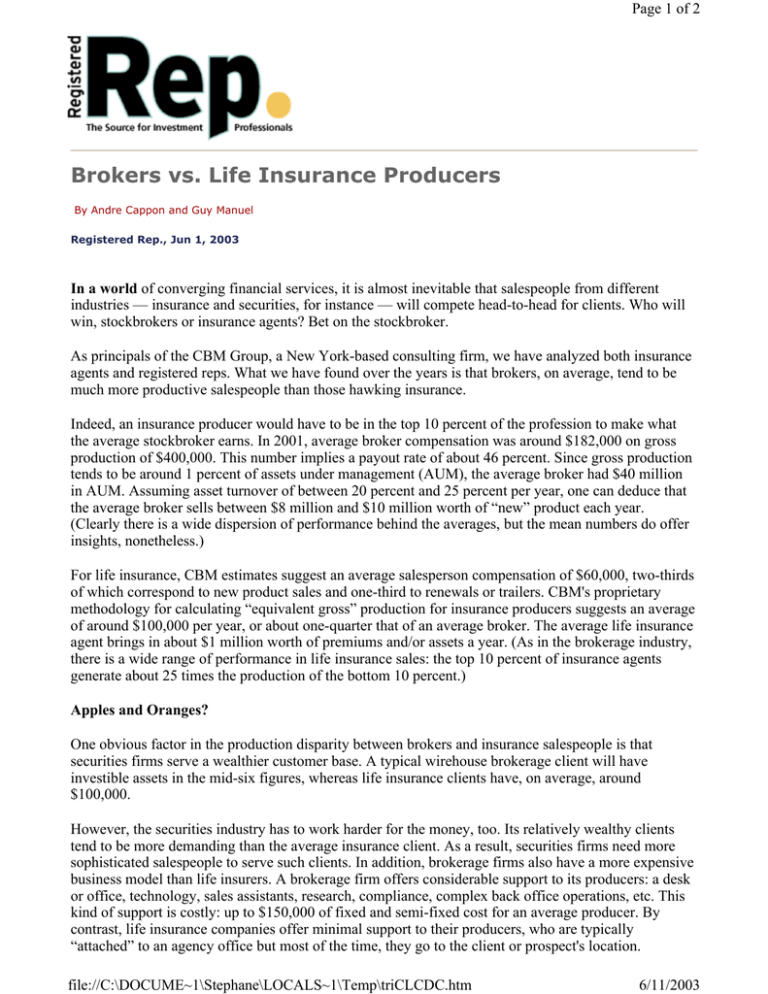
Page 1 of 2
Brokers vs. Life Insurance Producers
By Andre Cappon and Guy Manuel
Registered Rep., Jun 1, 2003
In a world of converging financial services, it is almost inevitable that salespeople from different
industries — insurance and securities, for instance — will compete head-to-head for clients. Who will
win, stockbrokers or insurance agents? Bet on the stockbroker.
As principals of the CBM Group, a New York-based consulting firm, we have analyzed both insurance
agents and registered reps. What we have found over the years is that brokers, on average, tend to be
much more productive salespeople than those hawking insurance.
Indeed, an insurance producer would have to be in the top 10 percent of the profession to make what
the average stockbroker earns. In 2001, average broker compensation was around $182,000 on gross
production of $400,000. This number implies a payout rate of about 46 percent. Since gross production
tends to be around 1 percent of assets under management (AUM), the average broker had $40 million
in AUM. Assuming asset turnover of between 20 percent and 25 percent per year, one can deduce that
the average broker sells between $8 million and $10 million worth of “new” product each year.
(Clearly there is a wide dispersion of performance behind the averages, but the mean numbers do offer
insights, nonetheless.)
For life insurance, CBM estimates suggest an average salesperson compensation of $60,000, two-thirds
of which correspond to new product sales and one-third to renewals or trailers. CBM's proprietary
methodology for calculating “equivalent gross” production for insurance producers suggests an average
of around $100,000 per year, or about one-quarter that of an average broker. The average life insurance
agent brings in about $1 million worth of premiums and/or assets a year. (As in the brokerage industry,
there is a wide range of performance in life insurance sales: the top 10 percent of insurance agents
generate about 25 times the production of the bottom 10 percent.)
Apples and Oranges?
One obvious factor in the production disparity between brokers and insurance salespeople is that
securities firms serve a wealthier customer base. A typical wirehouse brokerage client will have
investible assets in the mid-six figures, whereas life insurance clients have, on average, around
$100,000.
However, the securities industry has to work harder for the money, too. Its relatively wealthy clients
tend to be more demanding than the average insurance client. As a result, securities firms need more
sophisticated salespeople to serve such clients. In addition, brokerage firms also have a more expensive
business model than life insurers. A brokerage firm offers considerable support to its producers: a desk
or office, technology, sales assistants, research, compliance, complex back office operations, etc. This
kind of support is costly: up to $150,000 of fixed and semi-fixed cost for an average producer. By
contrast, life insurance companies offer minimal support to their producers, who are typically
“attached” to an agency office but most of the time, they go to the client or prospect's location.
file://C:\DOCUME~1\Stephane\LOCALS~1\Temp\triCLCDC.htm
6/11/2003
Page 2 of 2
Brokerage firms need more productive salespeople to offset the higher cost structure, and, as a result,
they tend to put much more pressure producers to, well, produce.
Exit Policies
All brokerage firms have strict “up or out” policies for trainees and experienced producers. The average
production of brokers almost always increases with years of service. In life insurance, however, it is
quite common to see producers who have been in the business for many years stagnate or even decline
in terms of production. Since their cost structure is almost fully variable as a function of production,
life insurance companies tolerate part-time and semi-retired producers and offer them the option of
working out of their homes.
Producer compensation is another major difference between the two industries. Brokers “eat what they
hunt.” Most of their compensation is directly tied to fees and transactions — commissions and sales
loads. In life insurance, trailers and renewal commissions are substantial, and it is quite possible for an
experienced life insurance producer to “slow down” but still make a comfortable living from renewals.
That said, when taking stock of the competition from the insurance industry, it would be a mistake for
brokers to be dismissive. (If for no other reason than because they are vastly outnumbered, 400,000 to
100,000.) But the fact remains that in a head-to-head competition for a client, a broker is likely to be
the fitter foe.
Andre Cappon is president and Guy Manuel managing director with The CBM Group, a New Yorkbased consulting firm specialized in the securities industry.
thecbmgroup.com
© 2003, Primedia Business Magazines and Media, a PRIMEDIA company. All rights reserved. This article is protected
by United States copyright and other intellectual property laws and may not be reproduced, rewritten, distributed,
redisseminated, transmitted, displayed, published or broadcast, directly or indirectly, in any medium without the prior
written permission of PRIMEDIA Business Corp.
© 2003 Primedia Business Magazines &
Media.
About Us | Contact Us | For Advertisers | For Search P
file://C:\DOCUME~1\Stephane\LOCALS~1\Temp\triCLCDC.htm
6/11/2003




